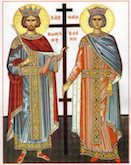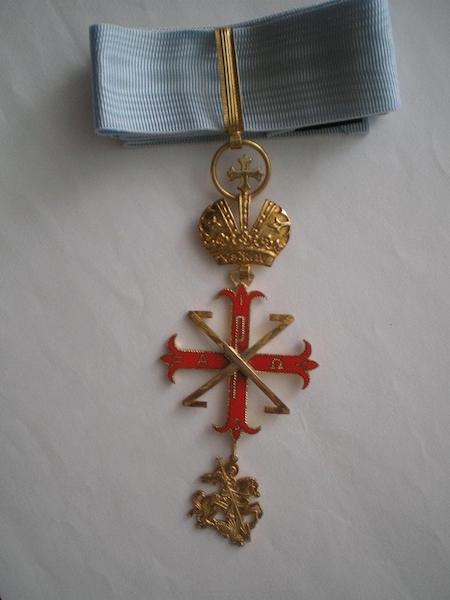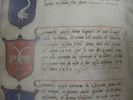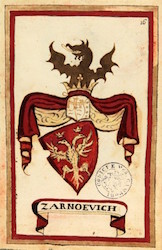THE TCHERNETICHS ARE DIRECT DESCENTANTS OF THE EMPEROR CONSTANTINE

"Among the great families who pride themselves in their ancestry and the nobility of their bloodlines is the House of Tchernetich which traces its origins back to the Constantine Emperors.
This lineage has been preserved down to modern times by the Prince of Montenegro though the lands themselves were stolen by the Ottoman armies". (from Mariano Ventimiglia's work, "Il sacro Carmelo italiano, vita del venerabile frate Pietro Cernovichio, alias Angelo, Principe di Macedonia, sepolto nel Carmine di Valenza di Spagna",) Venice, 1779.
"Il sacro Carmelo italiano"
ovvero l'Ordine della SS. Vergine
Madre di Dio Maria del Monte Carmelo
Mariano Ventimiglia
|
|
"Il sacro Carmelo italiano"
Vita del venerabile frate Pietro Cernovichio,
alias Angelo, Principe di Macedonia,
sepolto nel Carmine di Valenza di Spagna.
Venezia, 1779
Mariano Ventimiglia
|

|
|

|
|
|

- Some members of the family, such as Komnenos Angelos Palaiologos, of the Greek Imperial House of Constantinople assumed, during various periods, the nickname "the Black" (signifying "fearless warrior") and then eventually the Slav surname Tchernetich (meaning the "Son of the Black of Montenegro") as sovereigns of Montenegro ( formerly known as Zeta's kingdom), Macedonia, Epirus and Serbia.
- 1190, Emperor Isaac II Angelos Komnenos writes the first statutes of the Constantine Order of Saint George.
- 1331, George Tchernetich Komnenos Palaiologos, Grand Voivoda of Montenegro, helps his cousin, Stephan "Dushan" Nemanyich, Emperor of Serbia, to conquer the throne.
- January the 10th, 1356, George Tchernetich of Montenegro, breaks the Hungarian siege of the Croatian city of Skradin then cedes it to the Venetians.
- 1356, Simeon Tchernetich, known also as Simeon Palaiologos, cousin of the above mentioned, is crowned Emperor of Serbia and rules until 1370.
- End of 14th century, the Tchernetichs are now sovereigns of Budva and the Gulf of Kotor.
- 1403 - 1435, George and Alexander Tchernetich are recognized by Venice as Lords of Montenegro and titular "Greek" and "Roman" Emperors of Constantinople, Serbia, Greece and Romania. The ruling house of Montenegro (the Venetian name) ceases to be called Zeta and adopts the present name of "Tchernetich", due to influence from both Venice and Cernei (the Black) Komnenos.
- 15th century, Stephan I Tchernetich marries Maria, sister of George Castriota-Skanderbeg, with whom he fights 64 battles against the Ottomans. Recent university studies have shown that the Tchernetichs and the Castriotas belong to the same family (through Ivan Komnenos-Castriota-Kastriotich, Count of Argirocastro).
- John (Ivan, 1465 - 1490), Grand Despot of Montenegro, in 1482 pays tribute to the Ottoman Sultan and is compelled to leave his son, Stanislav, in Istanbul as a hostage. Sultan Bayazid II recognizes Ivan's sovereignty in Montenegro by conferring the dignity on him of Ivan-beg (Prince Ivan) or Skanderbeg. Ivan marries Goislava, daughter of the Albanian Prince George Arianiti Komnenos. He marries a second time in 1469 to Maria, daughter of Stephan, King of Bosnia and Duke of Herzegovina.
- 1468, George Castriota Skanderbeg dies and the Tchernetichs adopt, for use in Albania and in the Ottoman Empire, the name of "Skanderbeg" going on to rule in Epirus using this name for some generations.
- 1473, Venetian Patricians appear in official documents with the surnames Tchernetich,
 Cernovicchio, Zernovicchio, Zarnovicchio, Angelos, Komnenos, Vukovich. Mario Sanudo
Cernovicchio, Zernovicchio, Zarnovicchio, Angelos, Komnenos, Vukovich. Mario Sanudo
 in his work "The lives of the Dogas, 1423-1474" describes various events such as the admission Giovanni Tchernetich into the nobility of the Great Council of Venice on 24 of February 1473.
in his work "The lives of the Dogas, 1423-1474" describes various events such as the admission Giovanni Tchernetich into the nobility of the Great Council of Venice on 24 of February 1473.
- 1479, Ivan Tchernetich leads his army of Serbs and Albanians to fight alongside the Spanish, thus receiving various titles and fiefs in Apulia and the south of Italy.
- 1481, Ivan Tchernetich returns to Montenegro as a tributary vassal of the Ottoman Empire.
- 1492, George Tchernetich, Sovereign of Independent Montenegro and "Emperor of Constantinople and Serbia," re-conquers the throne with the help of the Venetians. He marries Elisabetta, daughter of the Venetian nobleman, Antonio Erizzo. George takes a printing press from Venice to the Cettigne Monastery and founds the first printing-house in the Balkans. He prints in the Cyrillic alphabet toward the end of 1496. He appoints Duke Bozhidar Vukovich (born in Podgoritza in 1460 - died 1539), as the head of the printing-house. He would later become imperial printer of Serbia and Montenegro in Venice.
- At the end of 15th century, Elisabeth, the daughter of George Tchernetich of Montenegro, marries Radu the Great, Grand Voivoda of Moldavia and Valachia. He also brings typographic art to what is today Romania.
- George Tchernetich, Grand Despot of Montenegro, impresses many Venetians by his height and charm ("Essendosi l'uomo più prestante del suo tempo... Et etiam lui, che è bellissimo homo et gran ben vestito d'oro a la grecha... Et la moglie con gran zoje vestita d'oro" writes Marino Sanudo, 1466-1535, in his Diarii) He also impresses them with his magnificent Byzantine dress and his wealthy retinue. Because he refuses to be a vassal to the Serene Highness he is imprisoned. Fortunately, the king of France, Louis XII, personally intervenes to set him free.
- George Tchernetich allies his troops to those of Louis XII and to those of the Marquis of Monferrato to fight Ludovico il Moro in order to conquer Milan. He then allies himself with the Venetians to fight in defence of Pisa against Florence. George returns to Milan from where he is exiled to his nearby cousins the Palaiologos, Marquises of Monferrato, from whom he asks men and material to prosecute the fight against the Ottomans. (The marquis Bonifacio XIII Palaiologos marries Maria Brankovich, daughter of the Emperor of Serbia, a close relative of the Tchernetichs from both the Palaiologos' and Brankovich's sides of the family).
- Stephan II Tchernetich (1496 - 1498), brother of Ivan, rules Montenegro and Albania using the name of Skanderberg, but still has to pay tribute to the Ottoman Sultan.
- 1513, Stanislav, third son of IvanTchernetich, rules Montenegro and Albania from 1513 to 1530 still using the name of Skanderberg.
- 1522, The Emperor of Serbia, Ivan II Tchernetich Nemanyich Komnenos Palaiologos, known as Cerneo or "The Black", musters and arms the militia of the Constantine Order of St. George for use against the Ottomans and later against both Ivan Zapolya, Prince of Transylvania and the Hapsburgs.
- 1526, John II Tchernetich is officially crowned Emperor of Serbia, Romania and Greece, as well as Titular Emperor of Constantinople at his capital Subotitza, in Voivodina.
- 1536, his son, Paul I Tchernetich of Serbia and Montenegro, has his hereditary rights guaranteed in perpetuity by Charles V of the Habsburgs.
- On the 17th of July 1551, Pope Julius III issues the Bull "Quad Alis" bestowing the Grand Mastery of the Constantine Order of Saint George and of the other Byzantine knighthoods to the House of Tchernetich-Komnenos.
- 1559, Pope Paul III confirms the Grand Mastery of the Constantine Order of St. George to Angelos Komnenos Tchernetich of Venice, Geronimo, Pietro and Nicola.
- On the 10th October 1576, further recognition from the Pope comes to the House of Tchernetich-Komnenos concerning the grand mastery of the Constantine order of Saint George, when he places the order under the protection of Saint Basil. The knights of the order are fully entitled to receive ecclesiastic and secular benefits, such as the priory of Brindisi's cathedral. Three Tchernetich dukes are buried there, in the St. Nicholas Basilica whose walls bear inscriptions attesting to that fact that are still clearly visible to this day.
- 1571, a number of Tchernetich princes fight in the battle of Lepanto on both sides, Christian and Ottoman.
- March the 22nd 1581, Frances de Medici, Grand Duke of Tuscany sends a letter to his ambassador at the court of Naples, Marquis Leonardo Salviati, in which he complains that "Don Peter Tchernetich of Croatia" grants the cross of the Constantine Order of Saint George in a manner similar to that of the Order of Saint Stephan of Tuscany, and requests him to plead with the Spanish viceroy, Juan de Zúñiga, for his intervention with Pope Gregorius XIII in order to "...reduce that cross to its original ancient shape".
- 1616, 1624, 1640, Stephan Ivan I Tchernetich, Emperor of Serbia and Titular Emperor of Constantinople, awards the Cross of the Constantine Order of St. George and "St. Stephen" to the soldiers of the campaigns against the Ottomans in Serbia, Zenta and Albania. The Austro-Hungarian Empire confers nobility and letters patentae in 1561, 1578, 1606, 1615, 1616 and 1640.
- 1683 - 1688, Arsenius Tchernetich, Voivoda and Orthodox Patriarch of Serbians, leads the exodus of Serbian armies from Montenegro into Voivodina in Hungary (now Serbia). He fights against the Ottomans alongside Piccolomini and Eugene of Savoy. Emperor Leopold I of the Habsburgs awards him letters patentae, titles and fiefs in Voivodina and around Budapest, where he names the city of Szentendre (St. Andrew) his capital.
- First half of the XVII century, Stephan Tchernetich, Prince of Macedonia and Croatia wears the "croatian" (it will be eventually called the necktie). This is a silk ribbon in red and black colours, the colours of Tchernetich family, elegantly knotted around the neck. Prince Stephan wears this while campaigning in Prussia during the Thirty Years' War (1618 - 1648). At Versailles his cavalry regiment, entirely made up of Balkan nobles wearing "croations" parades before Louis XIV and his court. From there the fashion of wearing a "croation" spreads to the rest Europe. The necktie is born.
- 29 April 1720, King Carlos grants letters patentae to Hungarian nobles as Princes and Counts of Macsa and Kis-Orosz.
- XVIII century, Empress Catherine II of Russia accepts the credentials of Prince Stephan Tchernetich as ambassador of "Serbia and Macedonia", to the Court of Saint Petersburg (even though Montenegro has lost its sovereignty to the Ottomans) with the promise of setting the Balkans free soon from the Ottoman yoke.
- On the 15th of September 1760, Count Tchernetich-Podgoritzan (the name deriving from Podgoritza, the capital of Montenegro), in his capacity as a colonel of a Russian regiment of Moldavian and Serbian Hussars, leads a famous assault on the Berlin capital of Frederick II of Prussia.
- In 1767, Stephan Tchernetich known as the "Little Czar" becomes Emperor of Montenegro and Serbia. In that same year he is killed by a Turkish assassin. To assist in the defence of Montenegro Catherine II of Russia sends a fleet of warships captained by Prince Orlov and also sends Prince Dolgorukij as military advisor. Under pressure from the advancing Ottoman forces Stefan Giorgio IV Tchernetich leaves the government in the hands of the Orthodox Metropolitan, Petrovic Njegos, and then leads his army to safety to Pannonia (Hungary).
- August 7th-18th 1799, Emperor Paul I of Russia awards the Tchernetichs the title of "Princes of the Russian Empire" for the main branch of family and the title "Counts of the Russian Empire" for the cadet branches with the appellative of "Podgorichan" (from Podgoritza).
- At the end of 1700s, Mosnier, the official portrait painter to the court of Louis XVI of France, paints Princess Anna Tchernetich (1772 - 1810), daughter of the Austrian (then Russian) General Simeon Tchernetich and wife of the well-known Russian scientist Ivan Muraviev Apostol (1770 - 1851), this painting now hangs in the St. Petersburg Hermitage museum.
- 1849, among the participants of the Hungarian rebellion in Kossuth, figures General Janos Damjanich, husband of Emilia Tchernetich of Montenegro, Countess of Mácsa and Kisz-Orosz.
- 1920, in the castle of Mácsa, near Arad, Transylvania, Elisabeth Tchernetich marries Eugene Dadanyi, Duke of Mingrelia, a Hussar officer. She is the daughter of Prince Theodor Tchernetich of Montenegro, Count of Mácsa and Kisz-Orosz, and of his second wife Olga who was the youngest daughter of Baron Eugene Duka de Kadar.
- The Tchernetichs of Montenegro in recent times remain in Austria, Hungary, Tyrol and Trieste where the father of the present head of the family resides.
- 2004, The Republic of Montenegro chooses the coat-of-arms of the House of Tchernetich, with minimal alterations, as the official symbol and flag of the nation.
|